
08 Oct My 50 Year Experiment With Yoga
I’ve played with yoga for almost fifty years. Here’s my story and what I’ve learned:
I started messing around with yoga at a young age because my mom used to practice along with one of the yoga television shows. If there was a pose that looked cool, I’d show off that I could do it too.

Paul at ten years old fooling around with a headstand.
My teen years were mostly about gymnastics, wrestling, and judo. These sports emphasized long periods of stretching to warm up and warm down. Since most stretching ultimately has its roots in yoga, even at a young age, I was practicing a watered down version of yoga.
So when, at age twenty-one, a friend brought me to a yoga class he was taking in Westchester County New York, yoga already seemed like an old friend. The instructor, Eunice Wellington, was a skilled and devoted yogi who’d practiced much of her life. She told me to call her Siddi, which was her yogic name.
At twenty one, my muscles were tight, but emotionally I was even tighter and more closed off.
On my second or third class SIddi came up to me before the lesson started, kissed me on the cheek and gave me a long hug. I turned red with embarrassment, but didn’t think much of it. Some people are touchy feely like that. However, her other students told me she normally didn’t show such affection with everyone, especially someone she barely knew.
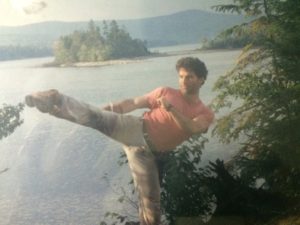
Paul in late 20’s posing for a sidekick in Maine
It was even more surprising because I wasn’t an ideal student. During class I’d stop to take notes. I could see Siddi didn’t like it, it subtly disrupted everyone. “If I just participatated,” she said, “yoga would eventually would enter and become part of me.” Never the less, in the middle of a posture I’d get up and write in my notebook. From my very first exposure to Siddi’s Hatha yoga I intuitively knew that each posture was a great gift. I wanted to remember every detail so I could practice at home. And right from the beginning, I practiced everyday, except the one evening I participated in class.
I’d only signed up for a two month course, which emphasized basic and intermediate asanas (postures), along with some pranayama, (breathing exercise) and meditation. A couple of weeks before the end of the course, Siddi came up to me. “Of course you’ll be continuing with yoga.” It wasn’t a question. She said it as if it could not be otherwise.
I knew she wanted me to stay, but when the course was finished, I never came back. My head was too full of martial arts. However, I faithfully practiced everything she taught me, nearly every single day, for the next 16 years.
Growth Through Practice
During those sixteen years of solo practice, I used my body as a laboratory. I’d hold the pose as long as I could to stretch the tissue. It took over a year of sincere practice to achieve the full splits. With yoga you are always growing. It’s a tremendous amount of fun to see how far you can go in any particular posture, and how far the posture will take you in every aspect of life.
The Ecstasy Factor
I watch the faces of people when they tell me they’re going to the gym. Sometimes I can see conflict or resistance, as if they’re about to do something they don’t fully enjoy. Nearly everyone relishes the benefits of exercise, but the ecstasy factor is what’s missing in exercise research…and in many people’s lives.
One should be as eager to do your practice as a dog is to go for a walk. Imagine how a dog gets excited when you pick up her leash. If you’re that excited to practice, you will be getting the ultimate benefit. For me, yoga has always provided ecstasy, and I’ve never grown weary of it.
My Second Yoga Teacher
I met my second yoga teacher in the summer of 1994. Sushil Bhattacharya, a yogi from India, was teaching a yoga therapy course in Portland Oregon. I signed up as a gift to myself for graduating chiropractic school. In the intensive two week workshop, he taught me so much about yoga and pranayama, when he invited me to take his month long training in Katmandu Nepal, I jumped on it.
I arrived in Katmandu in November 1994. On my second day I came down with a terrible case of amebic dysentery. I had an extremely high fever and was pooping explosive diarrhea forty times a day. Though I was in critical condition, I still managed to practice yoga, at least after the intense fever broke and I was able to get out of bed. By the end of the month I weighed less than 110 pounds; I’d lost almost twenty-five percent of my body weight.
But apparently the dysentery was, in part, a healing crisis. There were deep seated toxins inside of me that were burned up and cleared out by the fever and diarrhea. When the smoke cleared, my body was more supple than ever before.
It seemed a minor miracle. I’d practiced the intermediate yoga I’d learned from Siddi for years, but could never coax my body into the more advanced poses. But with just a few minor adjustments from Sushil I was able to accomplish the full postures. After the unforgettable month of sickness and yoga progress, Sushil awarded me with a name and title in yoga.
The name he gave me is Ananda Shakti. It means blissful power. The title he bestowed was Yogashri, which means the beauty of yoga.
You can see in this picture with Sushil, that my body was still stiff and awkward. With practice my spine and muscles further stretched out and I was able to have more poise and ease in the postures, which are illustrated by these poses a year or so later. (I also gained back my weight)

Yoga in Nepal with my second yoga teacher, Sushil

yoga in my late 30’s in Washington
Yoga Beyond 40
My forties were an intensely busy time that encompassed marriage, the birth of my son, divorce, and building my healing practice. Through it all I embraced yoga. And every year, I continued to grow more flexible.
If there’s anything I’d like to share with you, it’s that dedicated, regular practice is the only secret.
The great Hatha yogi BKS Iyengar once said: “the mastery of yoga is in the practice of yoga.” After many years of solo practice I came to consider that playing with yoga at least two times a day is ideal.
Think of it this way: we eat, sleep, and defecate daily. We breathe constantly. I began to consider yoga, not an optional activity, or a form of exercise, but as a necessary activity of life. I feel its better to practice, even for twenty minutes, twice a day than to go to a ninety minute yoga class three times a week.
Constant regularity is the key to maintaining the body. Have you ever heard the expression: “Every minute of meditation is a minute of Buddha?” I look at yoga in a similar way. Don’t worry if you don’t have much time. Practice is like water wearing down a stone. It counters the effects of gravity, inertia, stress, and aging. I give busy people a series of poses that takes less than a minute. Even if they only do this series several times a day, it will improve their health. When they experience the benefits they often come looking for more. (see 90 second yoga)
More Than Physical
Though Hatha yoga is certainly exercise, it is more than mere calisthenics. Yoga balances not only the gross physical body, but also the subtle energetic or electric body. By keeping circulation moving in the energetic body, disease can be warded off before it reaches the physical body. The balancing effect of regular yoga is a tremendous antidote to a busy lifestyle.

Yoga pose in mid 40’s
As my fiftieth year passed I still retained all my strength and flexibility and, even with a head full of grey hair, was still making gains. Look at the difference in this Scorpion pose in my thirties and the one almost twenty years later in my fifties.

Scorpion in my thirties
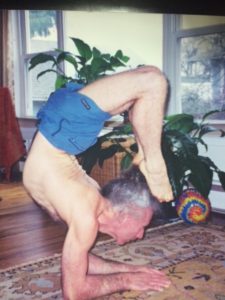
More flexible in my mid 50’s
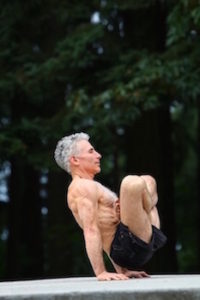
Yoga Postures in My Early Fifties

Yoga Postures in My Early Fifties
Yoga After Brazilian Jiu Jitsu
At 52, my daughter was born and at 53 I started Brazilian Jiu Jitsu, Both were life changing events. A young baby took a tremendous amount of time and energy, and the Jiu Jitsu changed my body. Dr. Bernard Jensen, the famous natural health pioneer used to say that your body molds to what you feed it, and this is true on so many levels. Your body, mind, emotions, and spirit mold around what you feed them.
The intense grappling literally rearranged the position of my spine. In a relatively short time, I lost over 12 inches of back bending flexibility. One might attribute it to age, but the real reason is that, in Jiu Jitsu, we fight a lot from the back, which over develops the abdominals and the lliopsoas muscles. Jiu Jitsu also tightened up the small muscles of the spine that I’d stretched out after so many years of back-bending practice.
If the Jiu Jitsu hadn’t re-molded my body, I bet I’d be just as flexible, possibly still making new gains. Yet, interestingly, with the loss of spinal extension, my back felt more stable. In the height of my flexibility, a disk would occasionally bulge and put pressure on a nerve. It didn’t happen often, maybe once every two years, but when it did, I went from a yogi to a man who couldn’t lift his briefcase or bend low enough to put on his shoes. I learned that, for me at least, a little less flexibility in the spine might actually be better because of the stability it provides.
Of course too much flexibility in the spine is a problem that few in our society have. It’s usually the opposite: people begin to lose suppleness in the spine in their mid twenties. And with the loss of flexibility comes loss of vitality. The spinal cord and cranial system is literally the highway through which flows our vital energy. As the flow is crimped we become biologically older.
Creating A Set Point Of Normal
In my fifties, especially with the demands of regular Jiu Jitsu, I witnessed how “normal” is always changing. I also learned just how important yoga is in making sure that one’s normal is pain free, and highly functional.
Our bodies automatically adjust towards balance. Medically, this internal balancing mechanism is called homeostasis. Homeostasis allows us to compensate around disease, inflammation, injuries, and physiological irregularities. The body will do its best with the resources it has, and tries to maintain the most efficient function possible. Trouble is the body can’t always do the job. Life may dish out more than we can balance.
If you hurt your low back, the way you move, and even the way you walk will be altered. Your body will begin to compensate around the injury. The low back may get stiffer and other parts of the body may get hyper-mobile. Its possible that the overall flexibility, and functionality of your body will begin to decrease. If nothing is done about it, pain and disfunction can become the new normal.
Treatment Interrupts The Pattern
Sometimes patients come to see me that have been in horrific accidents. They are in constant pain. Treatments of massage, acupuncture, Qigong, cranial sacral, and chiropractic help to temporarily interrupt the pattern. If I can get them pain free for 30 minutes, it’s a good start. The plan is to keep interrupting the pain pattern with regular treatment, until the body remembers that being pain free with full range of motion is normal.
Even apart from frank injury, the body is always creating a new normal. It often happens so slowly we hardly notice it. As we age, the increase of pain and loss of function happens gradually. The spine and joints lose mobility and the muscles become tighter and weaker. We take it for granted that age brings more pain and less function. And as the years pass, we get used to the new normal––and we deal with it. But if you could watch a video of yourself at thirty and then see how you are at sixty or seventy, it’s clear that the functionality of what you consider normal has changed dramatically.
Remember the set point of normal is always changing––depending on what you do with it.
Yoga: Your Best Overall Plan To Constantly Interrupt The Pattern
After nearly half a century of practice I have found that regular yoga, in conjunction with nutrition, quality rest, and inner harmony helps to bring the body and mind to an optimal level of health. A state in which pain free is normal. Yoga not only creates, but also maintains a baseline of well being.
In February 2015 I went to Miami to study Jiu Jitsu with a well known instructor. He had me training from 4-7 hours a day every day, for 6 days in a row. Considering that I normally train 4 days a week in Jiu Jitsu, this was a big step out of my comfort zone. Without the day of rest I was accustomed to, I was fatigued and my body was sore––a good recipe for injury. As always, I performed yoga at least twice a day: before breakfast, before dinner, and frequently right after the grappling. After each yoga session I literally felt myself returning to my normal point, which is the pain free, vibrant feeling I’m accustomed to experiencing.
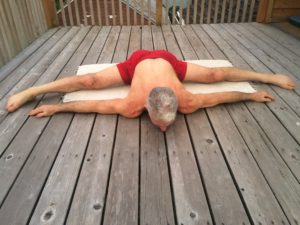
Yoga Postures At 60

Yoga Postures At 60
Generally, kids are more flexible than adults, but yoga made me more flexible than when I was a child. I’m beginning my sixth decade, and am still much more flexible than I was at twenty.
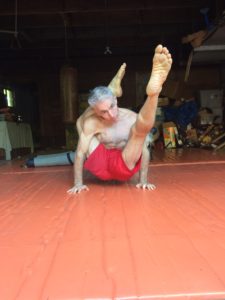
Yoga Postures At 60

Yoga grounds and centers
There seems to be No Limit To Yoga
I encourage everyone, of all age and levels of health to practice yoga. Yoga can be practiced in a hospital bed, wheel chair, in an airplane, or almost anywhere. Yoga can be as simple as flexing your ankles. Nor does it take much instruction. In 50 years, I’ve only had three months of formal training. My progress came from a sincere interest that kept my heart and soul focused.
Since I was a boy, yoga has become a household word. Most people already know some yoga. If not, you can easily find a second hand yoga tape, or take classes anywhere. Begin now! String a few moves together, and start your daily practice! Whatever you give to yoga, it will return back a thousand times.
This brief article spoke only about the physical postures of Hatha yoga. When the pranayama (breathing exercises) and meditation are included, you have one of the best possible tools for a healthy life of joy and celebration.
Yoga might be the best friend you ever have.
Most people are familiar with Hatha yoga, but there are many hundreds, if not countless, practices that are considered yoga. The ultimate goal of yoga is surrender of the ego self into the whole. When the river empties into the sea, you become one with life. This is the real yoga! (See my book The Road To Peace Runs Through The Valley Of Death. How To Be Your Own Shaman)
I am passionate about teaching yoga, nutrition, meditation, Qigong, and Brazilian Jiu Jitsu to those who want to rejuvenate their lives, and become biologically younger. I’m also creating programs for pre-teens and challenged teens that includes yoga, Brazilian Jiu Jitsu, meditation, nutrition, and rites of passage. Please contact me if you are interested.
*** I googled Eunice Wellington and saw that she died at a very old age. She taught well into her nineties. Obviously, I only knew her for a short time. I wasn’t aware that she was a well-respected and renowned yoga pioneer. I’ll always be grateful to Siddi for the gifts she gave me on many levels. She’s a true yogi.
I’m tremendously grateful to Sushil as well.




No Comments